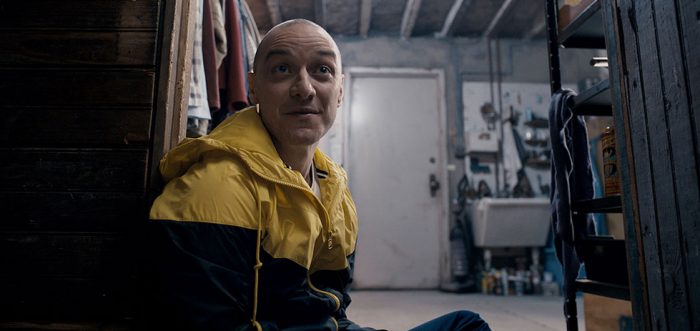
There’s a moment in Luc Besson’s Lucy where Scarlett Johansson’s titular character, whose ‘brain usage’ will go from 10% to 100% over the course of the film, sits on an operating table in Taipei. She holds the surgeons at gunpoint until they agree to cut open her abdomen to remove a bag of synthetic drugs that has given her strange new powers. While the anesthetic-less operation is underway Lucy calls her mother. The camera pushes in on her face, a blank stare that succumbs to a quivering lip, an involuntary bout of tears. She tells her mother that she can feel everything, the enormity of human experience. She tells her mother that she loves her and that she can feel, literally feel, the weight of decades of affection. In this sequence everything else in the film starts to bleed away: the absurdity of the pseudoscientific plot, the popping colour palette. It’s a perfect, singular moment, the best two minutes of Johansson’s acting career. What makes it so integral to Lucy’s overall impact is that this sequence not only suggests a sincerity to the bonkers plotting of the film but also to its lead character, that despite her eventual ascension to the superhuman she is just a human: scared, confused, alone. It’s a test for the audience, a crossing of the Rubicon, whether they can embrace this sincere moment not in spite of but because of the film’s delirium, or whether it rings little more than laughable.
M. Night Shyamalan’s Split banks on something similar. Though it’s not one moment, the film’s emotional impact relies on a parallel narrative. Casey (Anya Taylor-Joy), abducted by a strange man and imprisoned in an underground bunker, has sudden flashbacks to her childhood. It’s in these moments that Shyamalan attempts to achieve something akin to Besson’s film, a sudden and surprising sincerity that makes a salient point: the monsters in our world are more likely to be seemingly ordinary people than those we stigmatise and shun. While the point is one worth making, the execution is clunky; Split doesn’t come close to conveying this realisation in any real emotional sense, it’s merely declarative. The simplistic piano score and overbearing colour correction add to what is already a cheap and clumsy depiction of real trauma.
Shyamalan presents certain characters as survivors and suggests that the horrors of personal experience directly correlate to personal development, whether that be physical or mental. Split has come under fire for this, particularly with regards to the depiction of mental illness. Kevin (James McAvoy) has a form of dissociative identity disorder (DID) and cycles through over twenty different identities, though in the film we only see a handful of that number. Shyamalan plays the disorder as pulp, knowingly goofy pseudoscience. Is it insensitive? Yes. Is it offensive? Perhaps. The writer/director takes pains to present Kevin as a unique case. His psychiatrist, Dr. Fletcher (Betty Buckley), through exposition dump after exposition dump, argues that Kevin represents a fascinating example of the human brain adapting and evolving post-childhood trauma. Her controversial claim is that the identity that takes charge of his brain at any one time can cause his body to undergo a series of changes as well. That’s the tip-off that, in classic Shyamalan style, signifies the final act of the film is going to break away from the already fairly loose confines of reality.
McAvoy’s performance, a string of reaction .gifs and accents, is good, but it’s not good enough (and nor is the writing) to hold up a film dependent on a chaotic and varied protagonist. As Patricia, a religious authoritarian, McAvoy manages to nail a fine line between humour and dread but as other identities his performance is less fascinating, gelatinous even. It’s never really cringeworthy, though; even when playing an oversized nine-year-old he manages to land on his feet. What’s more of an indictment is that the drama created by these fractured identities plays out best in scenes of exposition between Kevin and Dr. Fletcher, where we learn of the internal power struggle (a ‘horde’ of resurgent identities). The fact that we’re contained to only those identities who propel the plot forward (an hostage film that hardly leaves the hostage-takers, for instance) leaves little room for fascinating digression or a more compelling and eclectic performance.1
It’s a Blumhouse film, after all; lean and hungry and limited in locations. Limited visually, too. Mike Gioulakis, who last shot the impressively sparse It Follows, does merely serviceable work here. It’s more visually compelling when pressed in on McAvoy’s face as he hams it up or in the rare and slightly unnerving wide shots that reinforce a societal divide, than when it’s cribbing from 10 Cloverfield Lane.
Unlike 10 Cloverfield Lane, what truly disappoints here is the final act. Shyamalan hesitates in taking his schlocky premise to its zenith, leaving the film hamstrung, caught between a delirious thriller and a would-be serious meditation on psychological and physical abuse. The lack of shocking moments in its final throes (bar a cringe-inducing nod to an earlier Shyamalan film in its final shot), or even genuinely pulse-pounding thrills, only underlines the slow-creeping blandness that comes to define Split. It might be outlandish but it’s just as limp, and that’s the kicker.
Around the Staff
| Jessica Ellicott | |
| Luke Goodsell |
